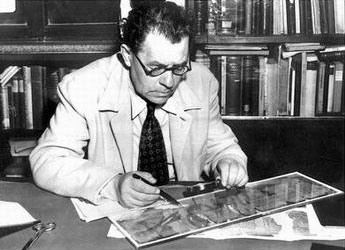Discovery
The first seven Dead Sea Scrolls were discovered by chance in 1947 by Bedouin of the Ta'amra tribe, in a cave (later given the name "Cave 1") near Khirbet Qumran on the northwest shore of the Dead Sea. Three of the scrolls were immediately purchased by archaeologist Eliezer Lipa Sukenik on behalf of the Hebrew University; the others were bought by the Metropolitan of the Syrian Orthodox Church in Jerusalem, Mar Athanasius Samuel. In 1948 Samuel smuggled the four scrolls in his possession to the United States; it was only in 1954 that Sukenik's son, Yigael Yadin, also an archaeologist, was able to return them to Israel, and they were ultimately entrusted to the Shrine of the Book Foundation. They have been on display in the Shrine of the Book at The Israel Museum, Jerusalem, since 1965.
Over the next few years, from 1949 to 1956, additional fragments of some 950 different scrolls were discovered in ten nearby caves, both by Bedouins and by a joint archaeological expedition of the École Biblique et Archéologique Française and the Rockefeller Museum, under the direction of Professor Father Roland de Vaux. The richest yield, from Cave 4, just opposite the site of Qumran, consisted of some 15,000 fragments. The last cave, Cave 11, was discovered in 1956, and the scrolls found there were in a reasonable state of preservation. Since then, only a few small scraps of parchment have been found in the Judean Desert (though not in the close vicinity of Qumran).
Apart from the first seven scrolls, which are entrusted to the Israel Museum, the majority of the fragments found by archaeologists and Bedouin are property of the Israel Antiquities Authority (IAA). Others are in the possession of institutions outside of Israel, such as the Jordan Archaeological Museum in Amman and the Bibliothèque Nationale de France in Paris, or in private hands (the Schøyen Collection, Norway).

Archaeologist, Prof. Eliezer Lipa Sukenik

Thanksgiving Scroll before unrolling